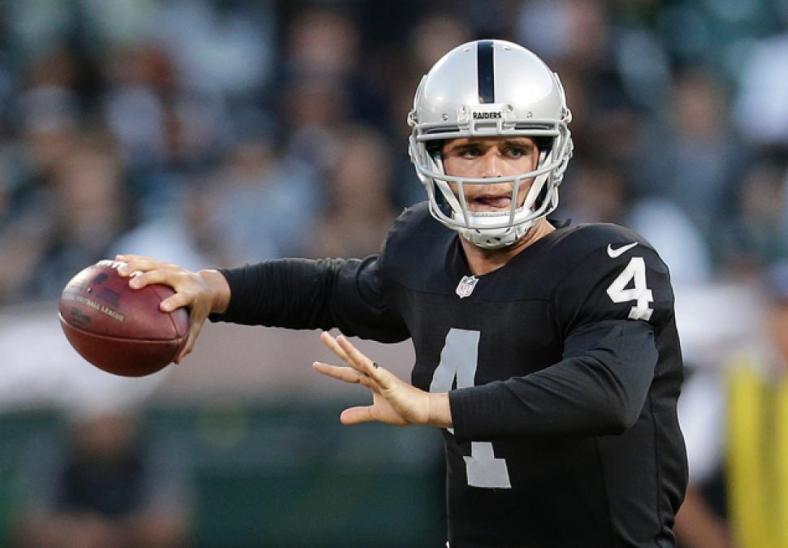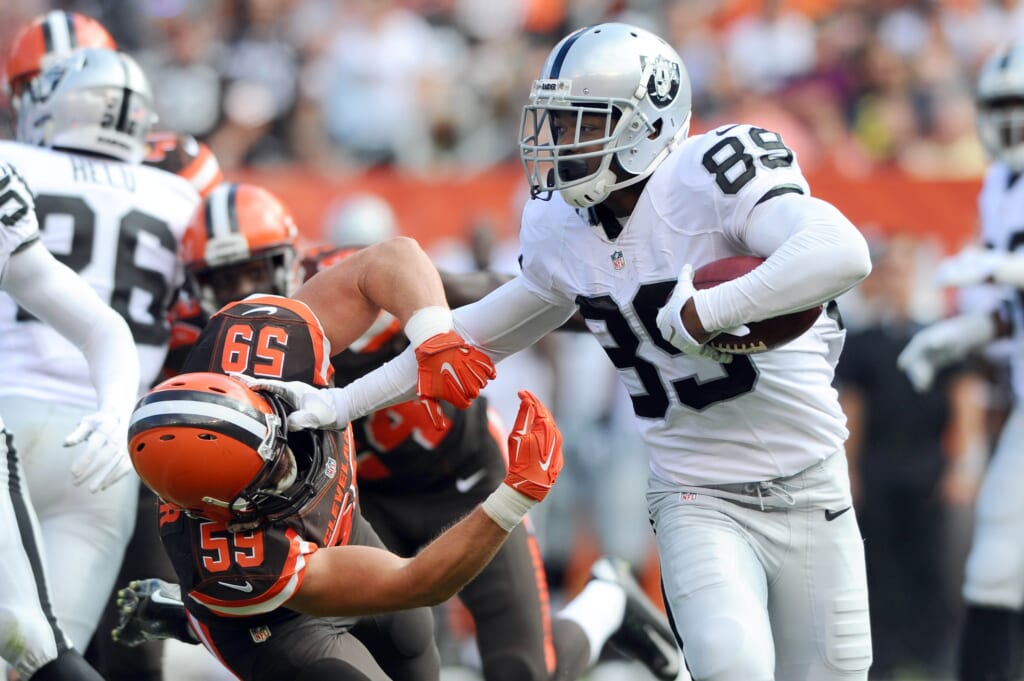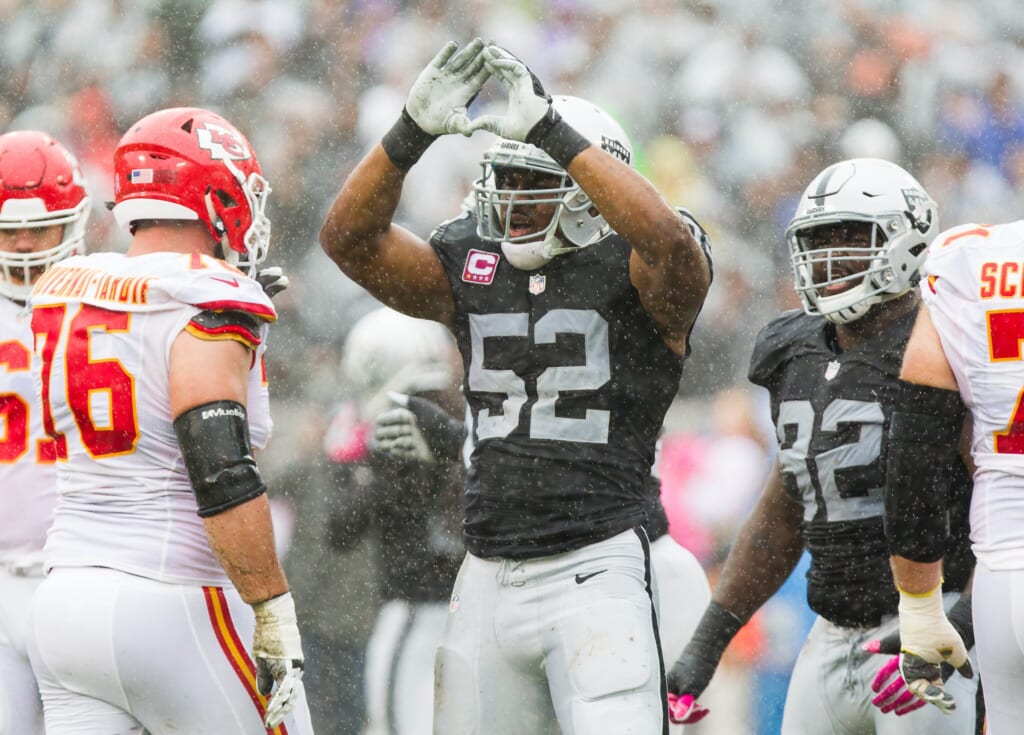
The 2016 Oakland Raiders were on the brink of Super Bowl contention. If not for a late-season injury to quarterback Derek Carr, they may have challenged the Patriots in the AFC.
Coming into this season, there are real expectations in Oakland for the first time since 2003. A parade down Broadway at 11th Street prior to the team’s impending move to Las Vegas after the 2019 season (probably) seems realistic after last year.
However, that parade won’t happen in 2017.
In fact, if anything the Raiders are set for some regression. This is still a playoff team, but a Lombardi Trophy shouldn’t be the expectation. It’s just not realistic.
Carr is one of the biggest reasons to expect setbacks for Oakland this year. He broke out as a star with an MVP-caliber 2016, throwing for 3,937 yards, 28 touchdowns and just six interceptions before an injury in Week 16. That last number — six interceptions — is worth exploring. While Carr’s stardom is no longer debatable, such a low interception total had more to do with luck than anything else. According to Cian Fahey’s charting, he threw a less impressive 24 interceptable passes last season. In fact, Carr’s accuracy could use some improvement; he was on the mark just 70.94 percent of the time, ranking 25th in the league per Fahey.
The other big factor for regression is Oakland’s record in close games. Though they went 12-4, the Raiders had 8.8 pythagorean wins and 8.9 estimated wins, per Football Outsiders. Not many of those 12 wins were of the dominant, blowout variety you might expect from a Super Bowl contender. Many hinged on just a couple plays that could have gone either way, and it’s rare to see a team get lucky so often in two straight years.
That’s not to pour cold water on this team. Carr may have gotten lucky with interceptions, but he still finished top-10 among quarterbacks in both DYAR and DVOA. Let’s be clear, the 26-year old is a franchise quarterback. It’s just that his decision-making needs more refinement than you might think.
Carr benefitted from his receiving corps last season and will this year as well. Amari Cooper is entering his third year in the league and looks like a bona-fide star. In 2016, Cooper had 83 receptions for 1,153 yards on a 63 percent catch rate. He also finished 13th among receivers with 231 DYAR. Across from Cooper on the outside, Michael Crabtree has enjoyed a resurgence in Oakland. He went for over 1,000 yards for the first time since 2012 last season and finished 18th among wideouts in DYAR.

Depth, however, could be an issue at receiver. Cooper and Crabtree had a combined 277 targets last season and the Raiders didn’t do much to address that problem during the offseason. Seth Roberts is still the No. 3 receiver after a season in which he had just 397 yards on a catch rate below 50 percent. Cordarrelle Patterson may take some snaps away from Roberts, but the Raiders will likely use him on special teams more than offense. The Raiders did add Jared Cook at tight end, but he’s a player of minimal impact. In Green Bay last season, Cook had just 30 receptions and finished outside the top-30 tight ends in both DYAR and DVOA.
Instead of focusing on receiver, Oakland made their biggest offseason acquisition at running back in Marshawn Lynch. The 31-year-old running back is coming out of a year in retirement. In 2015, he played just seven games due to injury and averaged just 3.8 yards per carry, thanks mostly to Tom Cable’s handiwork on Seattle’s offensive line. That’s enough reason for skepticism when it comes to Lynch. But at the same time, anyone who’s ever watched him understands the potential here. Lynch rushed for over 1,200 yards every year from 2011-2014, can pick up short yardage on a whim and functions well as a receiving threat. Backup RB Jalen Richard should get a lot of those third-down snaps, especially early in the year, but don’t underestimate Lynch as a receiver.
It’s of no small matter that Lynch will be running behind one of the best offensive lines in football. Left tackle Donald Penn is 34 years old, but he’s coming off a Pro Bowl season in which he ranked eighth at the position in snaps per blown block, according to Football Outsiders’ Almanac. Kelechi Osemele, the left guard, didn’t allow a sack in 2016 and blew just 11 blocks all year, per FOA. Center Rodney Hudson ranked third at the position with an 89.1 PFF grade. Right guard Gabe Jackson ranked fourth at the position in snaps per blown block, according to FOA. The only potential hole on the line is at right tackle, where Marshall Newhouse is set to start. Newhouse struggled with the New York Giants last season with a 56.4 PFF grade. However, being surrounded by great players could be a boon to his game. This unit led the league in pressure rate last season, per FOA, and may be set to do the same this year.
Defense was Oakland’s problem area last year and it hasn’t gotten much better. In particular, the defensive line is an issue. No defensive tackle on the team played over 400 snaps last season and it looks like there will be a rotation at nose tackle again this year. Justin Ellis is likely to start despite a paltry 63.3 PFF grade in 2016. Expect the 23-year old Darius Latham to see a good amount of time at the position, though. Latham struggled in 2016 with a mere 48.2 PFF grade, but the Raiders will want to develop the second-year man. Third-round pick Eddie Vanderdoes could also move into the rotation. At defensive end, Oakland will likely be dependent on Mario Edwards. Edwards played just two games in 2016 due to injury, but he put up respectable numbers as a rookie two years ago. Opposite him, Jihad Ward was pretty terrible last year. He had an abysmal 70 percent run stop rate, per FOA, along with a 39.3 PFF grade. Denico Autry will be a part of the rotation on early downs as well. His 88 percent run stop rate in 2016 is worth highlighting, however, Autry still had a 45.8 PFF grade including a 44.6 run defense split.
It’s hard to find a positive with this group. The Raiders were 23rd in adjusted line yards last season and the front three simply didn’t make an impact. As with many teams, most of Oakland’s pressure came off the edge. There’s a good argument that defensive end Khalil Mack is the best defensive player in football thanks mostly to his growth as a pass rusher. In 2016, he had 11.0 sacks, 20 hits and 50 hurries. Mack also led all edge rushers in PFF grading and won the Defensive Player of the Year Award. At age 26, he’s only just entering his prime.

Bruce Irvin posted strong pass rushing numbers as well, posting seven sacks, 22 hits and 38 hurries, per FOA. Irvin also had an 81.4 PFF grade, ranking 23rd among edge rushers. Shilique Calhoun, a second-year player, will get some time as a rotational pass rusher, too.
Inside linebacker was a position Oakland had to address during the offseason and it’s hard to say they did a good job. The only acquisition they made outside the draft was signing Jelani Jenkins on a one-year deal. Jenkins played just nine games in 2016 and had a 30.1 PFF grade. With Perry Riley and Malcolm Smith gone, Corey James may be forced into an every-down role, which is a scary prospect. Though James had an impressive 74 percent run stop rate last season, he also had a horrific 28 percent success rate in coverage, according to FOA. Fifth-round pick Marquel Lee starts the season manning the middle, but he struggled during the preseason. It’s tough to believe in this group. The Raiders ranked 24th in pass defense DVOA over the middle of the field last year, including a terrible 25.3 percent DVOA to the short middle. Those numbers may not get better.
If the defense improves at all this year, it will be because of the secondary. Cornerback Sean Smith was the subject of some high-profile failures last season and generally struggled. He had a 49 percent success rate and gave up a sky-high 9.7 adjusted yards per target, according to FOA. However, we know Smith can do better because we saw it from him with the Kansas City Chiefs. He also had an 83.5 PFF grade just last season. All Smith has to do is cut out those embarrassing breakdowns on deep balls and we could be having a different conversation around him a month from now. Opposite Smith, David Amerson is a fairly average. He had a 70.7 PFF grade and 48 percent success rate in 2016, per FOA. First-round pick Gareon Conley could eventually replace Amerson as a starter on the outside. The Ohio State product may be an awkward fit in Oakland’s scheme, which primarily employs zone coverage. Conley was much more comfortable in man during college, but allowed just 0.51 yards per coverage snap last season, per PFF. He has the speed and agility to keep up with most receivers. Conley can also get physical at the line of scrimmage if needed. If not for sexual assault allegations for which he was eventually cleared, Conley probably would have gone higher than 24th overall in the draft. Nickel back T.J. Carrie had a solid 2016, putting up a 51 percent success rate over just 378 snaps, per FOA.
At safety, Karl Joseph is coming off a strong rookie year. His 55 percent success rate in 2016 was 10th at the position last year, per FOA. Next to him, free safety Reggie Nelson is 34 but ranked second with a 61 percent success rate in 2016, per FOA. Assuming health, this duo could be the best part of the defense.
The Raiders may not match their 12-win total from last season, but this is still a very good team. Even in a stacked AFC West, Oakland should return to the postseason, this time with Carr at the helm. That said, a Super Bowl is not likely in store for this team, which is still flawed.
If you would like to learn more about the advanced stats we used, check out FootballOutsiders.com, which is largely free, or ProFootballFocus.com which is not.